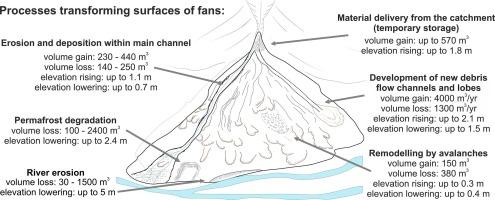Annual dynamics of periglacial alluvial fans mapped and quantified using time series of UAV data in Svalbard
IF 5.7
1区 农林科学
Q1 GEOSCIENCES, MULTIDISCIPLINARY
引用次数: 0
Abstract
The location of alluvial fans at the intersection of the lithosphere, hydrosphere, and atmosphere makes them valuable in recording long-term environmental changes. Short-term (annual) surface morphological changes of fans are also important, as they provide a geomorphological record of high-magnitude, low-frequency processes like debris flows or avalanches, which can pose a risk to human life, infrastructure, and cultural heritage. Our study focused on the annual dynamics of fans in Spitsbergen, Svalbard. This high-Arctic location is essential because it provides insight into the dynamics of fans in an area where climate warming is progressing at one of the highest rates on Earth, which can potentially lead to an increase in the frequency and/or magnitude of geomorphological processes. We quantified the geomorphological changes in surfaces of four debris-flow-dominated alluvial fans non-affected by direct human activity. High-resolution (cm-scale) elevation data were collected using a time series of UAV surveys conducted annually between 2015 and 2019. Our research has shown that most of the area (88–99 %) of individual fans remained stable during the studied period. However, we were still able to identify significant morphological changes using UAV data when high-magnitude, low-frequency processes such as debris flow, avalanche, or ground collapse occurred. The area of the individual fan that experienced elevation changes greater than the minimum level of detection (0.10 m) varied depending on the year, ranging from 0.2 % to approximately 8 %, with significant spatial and temporal variability. The volume of changes ranged from −2200 m3 to +4000 m3 per year, with the highest recorded erosion being 5 m and the highest deposition being 2.1 m per year. The variation in geomorphological response was caused by multiple factors, including fan and catchment morphometry, surface composition, timing of specific events, presence of permafrost, and the diversity of geomorphological processes that transformed fan surfaces.

利用斯瓦尔巴无人机数据的时间序列绘制和量化冰川冲积扇的年度动态图
冲积扇位于岩石圈、水圈和大气圈的交汇处,因此在记录长期环境变化方面具有重要价值。冲积扇的短期(年度)地表形态变化也很重要,因为它们为泥石流或雪崩等高强度、低频率过程提供了地貌记录,而这些过程可能对人类生命、基础设施和文化遗产构成威胁。我们的研究重点是斯瓦尔巴群岛斯匹次卑尔根岛扇的年度动态。这个北极高纬度地区是地球上气候变暖速度最快的地区之一,气候变暖有可能导致地貌过程的频率和/或规模增加,因此研究该地区的扇形地貌动态至关重要。我们对未受人类活动直接影响的四个以泥石流为主的冲积扇表面的地貌变化进行了量化。在 2015 年至 2019 年期间,我们利用无人机勘测时间序列收集了高分辨率(厘米级)高程数据。我们的研究表明,在研究期间,单个冲积扇的大部分面积(88-99%)保持稳定。然而,当发生泥石流、雪崩或地面塌陷等高强度、低频率过程时,我们仍能利用无人机数据识别出显著的形态变化。单个风扇的海拔变化超过最小检测水平(0.10 米)的面积因年份而异,从 0.2% 到约 8%,具有显著的空间和时间差异性。每年的变化量从 -2200 立方米到 +4000 立方米不等,记录到的最高侵蚀量为每年 5 米,最高沉积量为每年 2.1 米。地貌响应的变化是由多种因素造成的,包括扇面和集水区形态、表面组成、特定事件发生的时间、永久冻土的存在以及改变扇面表面的地貌过程的多样性。
本文章由计算机程序翻译,如有差异,请以英文原文为准。
求助全文
约1分钟内获得全文
求助全文
来源期刊

Catena
环境科学-地球科学综合
CiteScore
10.50
自引率
9.70%
发文量
816
审稿时长
54 days
期刊介绍:
Catena publishes papers describing original field and laboratory investigations and reviews on geoecology and landscape evolution with emphasis on interdisciplinary aspects of soil science, hydrology and geomorphology. It aims to disseminate new knowledge and foster better understanding of the physical environment, of evolutionary sequences that have resulted in past and current landscapes, and of the natural processes that are likely to determine the fate of our terrestrial environment.
Papers within any one of the above topics are welcome provided they are of sufficiently wide interest and relevance.
 求助内容:
求助内容: 应助结果提醒方式:
应助结果提醒方式:


